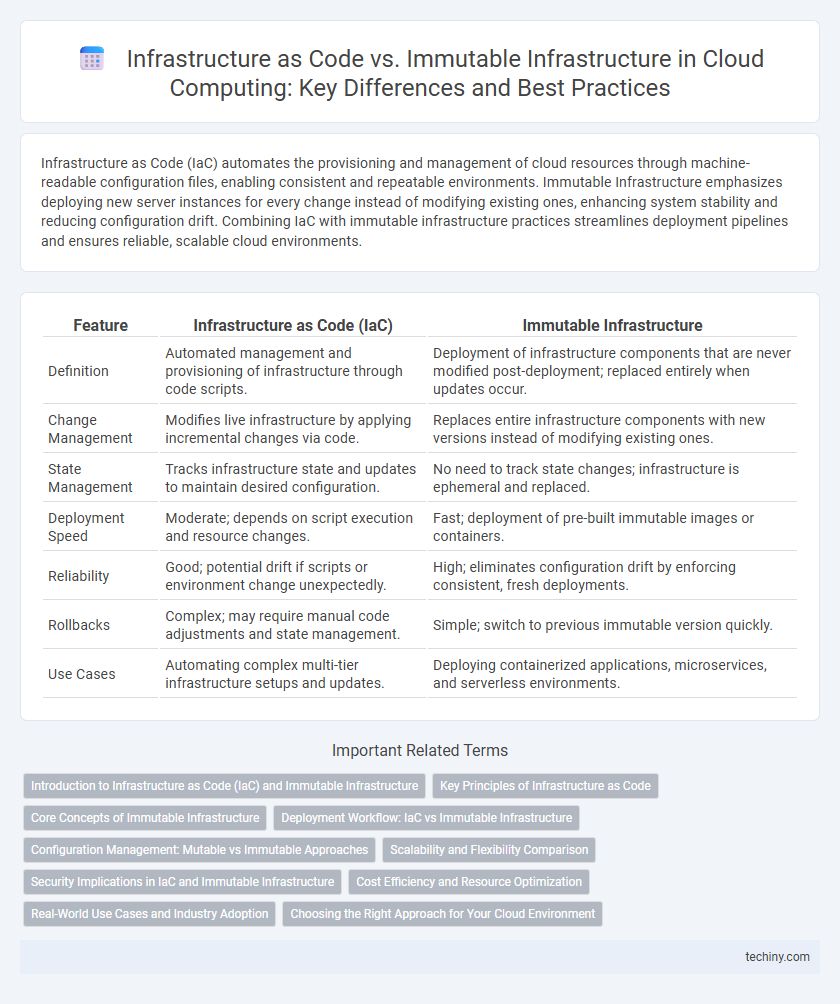Infrastructure as Code (IaC) automates the provisioning and management of cloud resources through machine-readable configuration files, enabling consistent and repeatable environments. Immutable Infrastructure emphasizes deploying new server instances for every change instead of modifying existing ones, enhancing system stability and reducing configuration drift. Combining IaC with immutable infrastructure practices streamlines deployment pipelines and ensures reliable, scalable cloud environments.
Table of Comparison
| Feature | Infrastructure as Code (IaC) | Immutable Infrastructure |
|---|---|---|
| Definition | Automated management and provisioning of infrastructure through code scripts. | Deployment of infrastructure components that are never modified post-deployment; replaced entirely when updates occur. |
| Change Management | Modifies live infrastructure by applying incremental changes via code. | Replaces entire infrastructure components with new versions instead of modifying existing ones. |
| State Management | Tracks infrastructure state and updates to maintain desired configuration. | No need to track state changes; infrastructure is ephemeral and replaced. |
| Deployment Speed | Moderate; depends on script execution and resource changes. | Fast; deployment of pre-built immutable images or containers. |
| Reliability | Good; potential drift if scripts or environment change unexpectedly. | High; eliminates configuration drift by enforcing consistent, fresh deployments. |
| Rollbacks | Complex; may require manual code adjustments and state management. | Simple; switch to previous immutable version quickly. |
| Use Cases | Automating complex multi-tier infrastructure setups and updates. | Deploying containerized applications, microservices, and serverless environments. |
Introduction to Infrastructure as Code (IaC) and Immutable Infrastructure
Infrastructure as Code (IaC) enables automated provisioning and management of cloud resources through machine-readable configuration files, improving consistency and scalability in cloud computing environments. Immutable Infrastructure involves deploying new versions of resources without modifying existing ones, ensuring reliability and simplifying rollback processes by replacing rather than updating infrastructure components. Both approaches enhance deployment efficiency and stability but differ in operational paradigms, with IaC focusing on automation and repeatability, while Immutable Infrastructure prioritizes non-changeable, disposable units.
Key Principles of Infrastructure as Code
Infrastructure as Code (IaC) emphasizes automating the provisioning and management of cloud resources through machine-readable configuration files, ensuring consistency and repeatability. Key principles include declarative coding, version control integration, and idempotency, which allow infrastructure to be reliably recreated across environments without manual intervention. Immutable Infrastructure complements IaC by replacing rather than modifying resources, promoting stability and reducing configuration drift in cloud deployments.
Core Concepts of Immutable Infrastructure
Immutable infrastructure ensures that servers or components are never modified after deployment, promoting consistency and reliability by replacing instances rather than updating them. It leverages automated provisioning tools to create new, pre-configured environments that reduce configuration drift and deployment errors. This approach contrasts with Infrastructure as Code, which focuses on defining and managing infrastructure through code but may still involve in-place updates.
Deployment Workflow: IaC vs Immutable Infrastructure
Infrastructure as Code (IaC) enables automated, consistent deployments by defining and managing infrastructure through code, allowing frequent updates and modifications within existing environments. Immutable Infrastructure deploys new instances for every change, eliminating in-place updates and ensuring consistency by replacing resources entirely during deployments. This results in IaC supporting flexible, iterative deployment workflows, while Immutable Infrastructure prioritizes reliability and stability by avoiding configuration drift through disposable components.
Configuration Management: Mutable vs Immutable Approaches
Infrastructure as Code (IaC) uses mutable infrastructure, allowing configurations to be updated and changed on existing servers through configuration management tools like Ansible, Puppet, or Chef. Immutable infrastructure emphasizes replacing servers entirely instead of modifying them, ensuring consistency and reducing configuration drift by deploying new, pre-configured instances with tools such as Docker or Terraform. The mutable approach offers flexibility in post-deployment changes, whereas the immutable approach enhances reliability and scalability by enforcing a consistent state.
Scalability and Flexibility Comparison
Infrastructure as Code (IaC) automates cloud resource provisioning, enabling rapid scaling and dynamic configuration changes that enhance flexibility in managing complex environments. Immutable Infrastructure, by deploying fixed, unchangeable server images, ensures consistency and reduces configuration drift but may limit real-time adaptability and scalability adjustments. While IaC supports granular updates and scalability through code-driven orchestration, Immutable Infrastructure prioritizes stability and predictability, requiring redeployment for scaling or changes.
Security Implications in IaC and Immutable Infrastructure
Infrastructure as Code (IaC) streamlines security by enabling automated, consistent, and repeatable provisioning of infrastructure, reducing human error and misconfigurations that lead to vulnerabilities. Immutable Infrastructure enhances security by replacing rather than modifying servers, minimizing configuration drift and attack surfaces, thus simplifying patch management and incident recovery. Both approaches improve security posture through automation and consistency, but Immutable Infrastructure's enforcement of immutability offers stronger protection against unauthorized changes and tampering.
Cost Efficiency and Resource Optimization
Infrastructure as Code (IaC) enables cost efficiency by automating resource provisioning and reducing manual errors, optimizing cloud spending through precise infrastructure management. Immutable Infrastructure enhances resource optimization by ensuring that deployed environments remain consistent and unaltered, minimizing configuration drift and lowering maintenance costs. Combining IaC with Immutable Infrastructure leads to streamlined operations, better scalability, and significant reductions in overall cloud resource expenditure.
Real-World Use Cases and Industry Adoption
Infrastructure as Code (IaC) enables automated provisioning and management of cloud resources using declarative scripts, widely adopted by enterprises like Netflix and Amazon to improve deployment speed and consistency. Immutable Infrastructure emphasizes deploying immutable server instances, ensuring environment stability and simplifying rollback, with companies such as Google and Etsy leveraging this approach for reliable, scalable production environments. Both paradigms are integral to DevOps workflows, with IaC dominating configuration management and Immutable Infrastructure enhancing resilience in microservices architectures.
Choosing the Right Approach for Your Cloud Environment
Choosing the right approach between Infrastructure as Code (IaC) and Immutable Infrastructure depends on your cloud environment's requirements for flexibility, scalability, and reliability. IaC enables automated provisioning and management of resources through declarative scripts, supporting dynamic changes and continuous integration workflows. Immutable Infrastructure simplifies deployment by replacing entire instances for updates, enhancing consistency and reducing configuration drift in environments where stability is critical.
Infrastructure as Code vs Immutable Infrastructure Infographic

 techiny.com
techiny.com